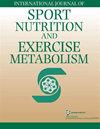Sweating Rate and Sweat Chloride Concentration of Elite Male Basketball Players Measured With a Wearable Microfluidic Device Versus the Standard Absorbent Patch Method.
IF 3
3区 医学
Q2 NUTRITION & DIETETICS
International journal of sport nutrition and exercise metabolism
Pub Date : 2022-04-27
DOI:10.1123/ijsnem.2022-0017
引用次数: 2
Abstract
The purpose of this study was to compare a wearable microfluidic device and standard absorbent patch in measuring local sweating rate (LSR) and sweat chloride concentration ([Cl-]) in elite basketball players. Participants were 53 male basketball players (25 ± 3 years, 92.2 ± 10.4 kg) in the National Basketball Association's development league. Players were tested during a moderate-intensity, coach-led practice (98 ± 30 min, 21.0 ± 1.2 °C). From the right ventral forearm, sweat was collected using an absorbent patch (3M Tegaderm™ + Pad). Subsequently, LSR and local sweat [Cl-] were determined via gravimetry and ion chromatography. From the left ventral forearm, LSR and local sweat [Cl-] were measured using a wearable microfluidic device and associated smartphone application-based algorithms. Whole-body sweating rate (WBSR) was determined from pre- to postexercise change in body mass corrected for fluid/food intake (ad libitum), urine loss, and estimated respiratory water and metabolic mass loss. The WBSR values predicted by the algorithms in the smartphone application were also recorded. There were no differences between the absorbent patch and microfluidic patch for LSR (1.25 ± 0.91 mg·cm-2·min-1 vs. 1.14 ±0.78 mg·cm-2·min-1, p = .34) or local sweat [Cl-] (30.6 ± 17.3 mmol/L vs. 29.6 ± 19.4 mmol/L, p = .55). There was no difference between measured and predicted WBSR (0.97 ± 0.41 L/hr vs. 0.89 ± 0.35 L/hr, p = .22; 95% limits of agreement = 0.61 L/hr). The wearable microfluidic device provides similar LSR, local sweat [Cl-], and WBSR results compared with standard field-based methods in elite male basketball players during moderate-intensity practices.用可穿戴微流控装置与标准吸收贴片法测量优秀男子篮球运动员的出汗率和汗液氯化物浓度。
本研究的目的是比较可穿戴式微流控装置和标准吸汗贴片在测量优秀篮球运动员局部出汗率(LSR)和汗液氯化物浓度([Cl-])方面的差异。研究对象为53名美国国家篮球协会发展联盟男子篮球运动员(25±3岁,92.2±10.4公斤)。运动员在中等强度、教练指导的训练(98±30分钟,21.0±1.2°C)中进行测试。使用吸水贴片(3M Tegaderm™+ Pad)从右前臂腹侧收集汗液。随后,通过重量法和离子色谱法测定LSR和局部汗液[Cl-]。使用可穿戴微流体装置和相关的基于智能手机应用程序的算法,从左前臂腹侧测量LSR和局部汗液[Cl-]。全身出汗率(WBSR)由运动前到运动后的体重变化测定,校正了液体/食物摄入(随意)、尿损失、估计的呼吸水和代谢质量损失。还记录了智能手机应用程序中算法预测的WBSR值。吸收贴片和微流控贴片对LSR(1.25±0.91 mg·cm-2·min-1 vs. 1.14±0.78 mg·cm-2·min-1, p = 0.34)和局部汗液[Cl-](30.6±17.3 mmol/L vs. 29.6±19.4 mmol/L, p = 0.55)无差异。实测WBSR与预测WBSR无差异(0.97±0.41 L/hr vs. 0.89±0.35 L/hr, p = 0.22;95%一致性限= 0.61 L/hr)。可穿戴微流控装置在中等强度训练中提供与标准场地方法相似的LSR、局部汗液[Cl-]和WBSR结果。
本文章由计算机程序翻译,如有差异,请以英文原文为准。
求助全文
约1分钟内获得全文
求助全文
来源期刊
CiteScore
5.00
自引率
8.00%
发文量
50
审稿时长
6-12 weeks
期刊介绍:
The International Journal of Sport Nutrition and Exercise Metabolism (IJSNEM) publishes original scientific investigations and scholarly reviews offering new insights into sport nutrition and exercise metabolism, as well as articles focusing on the application of the principles of biochemistry, physiology, and nutrition to sport and exercise. The journal also offers editorials, digests of related articles from other fields, research notes, and reviews of books, videos, and other media releases.
To subscribe to either the print or e-version of IJSNEM, press the Subscribe or Renew button at the top of your screen.

 求助内容:
求助内容: 应助结果提醒方式:
应助结果提醒方式:


